Posts Tagged ‘Quality Control Services In China’
Key Elements of Manufacturing Contracts You Should Know

In the world of manufacturing, contracts play a crucial role in establishing and regulating business relationships between manufacturers and their clients. These legal agreements outline the terms and conditions under which goods are produced, ensuring that both parties are protected and their rights and obligations are clearly defined.
This article will delve into the key elements of manufacturing contracts that every business owner should be familiar with. By understanding these essential components, you can enter into contracts confidently, safeguard your interests, and foster successful partnerships.
Parties Involved
The first fundamental element of a manufacturing contract is identifying the parties involved. This section should clearly state the names and contact details of both the manufacturer and the client.
It’s essential to accurately represent the legal entities or individuals entering into the agreement to avoid any confusion or disputes in the future. Including a brief description of each party’s business activities can also provide context and establish the nature of the relationship.
Scope of Work
The scope of work section defines the specific products or services to be manufactured by the supplier. It should include detailed descriptions, specifications, and any relevant technical documentation.
This section serves as a blueprint for the manufacturing process, ensuring that both parties are on the same page regarding the expected deliverables. Clear and concise language is essential in this section to minimize the risk of misinterpretation or ambiguity.
Pricing and Payment Terms
One of the most critical aspects of any manufacturing contract is the pricing and payment terms. This section should outline the agreed-upon pricing structure, including the cost per unit, any applicable discounts, and payment milestones.
Specify the payment method, whether it’s a lump sum, installment, or a combination of both. Additionally, include details about late payment penalties, currency, and any additional charges such as taxes or shipping fees. By clearly defining the financial aspects, this section ensures transparency and minimizes financial disputes.
Quality Assurance and Inspection
To maintain product quality and ensure customer satisfaction, a manufacturing contract should include provisions for quality assurance and inspection. Clearly define the quality standards, testing procedures, and acceptance criteria that the manufactured goods must meet.
This section should also outline the rights and responsibilities of both parties concerning inspection and quality control. By setting these parameters, you can mitigate the risk of receiving substandard products and establish a process for resolving quality-related issues.
Intellectual Property Rights
Intellectual property (IP) rights are of paramount importance in manufacturing contracts. This section should address ownership and protection of intellectual property associated with the manufacturing process, such as patents, trademarks, copyrights, and trade secrets.
Specify who will retain ownership of any new inventions or improvements made during the manufacturing process. Additionally, outline confidentiality obligations to safeguard sensitive information shared between the parties. Clear guidelines on intellectual property protect your innovations and prevent unauthorized use or disclosure.
Term and Termination
The term and termination section establishes the duration of the manufacturing contract and the circumstances under which either party can terminate the agreement. Clearly state the contract’s start date and end date, as well as any provisions for renewal or extension.
Include details on the notice period required for termination and any consequences or penalties associated with early termination. A well-defined termination clause ensures that both parties have a clear understanding of their rights and obligations throughout the contract’s duration.
Dispute Resolution
In the event of a dispute or disagreement, having a clearly defined dispute resolution process can help resolve issues efficiently and avoid costly litigation. This section should outline the preferred method of dispute resolution, such as negotiation, mediation, or arbitration. Specify the jurisdiction and venue for any legal proceedings.
It’s crucial to include a provision for resolving disputes amicably before resorting to legal action. A well-crafted dispute resolution clause promotes fair and timely resolution, preserving the business relationship between the manufacturer and the client.
Manufacturing contracts are vital tools for establishing successful business relationships in the manufacturing industry. By understanding the key elements of these contracts, you can ensure that your manufacturing agreements are comprehensive, fair, and beneficial to all parties involved.
Working with a manufacturer like Shield Works will make the process much easier. Our western background and 18 years of experience will provide a solid foundation for your manufacturing endeavors, minimize risks, and promote long-term success. Call us today!
Tips to Make Your Contract Manufacturing Process in China Easier
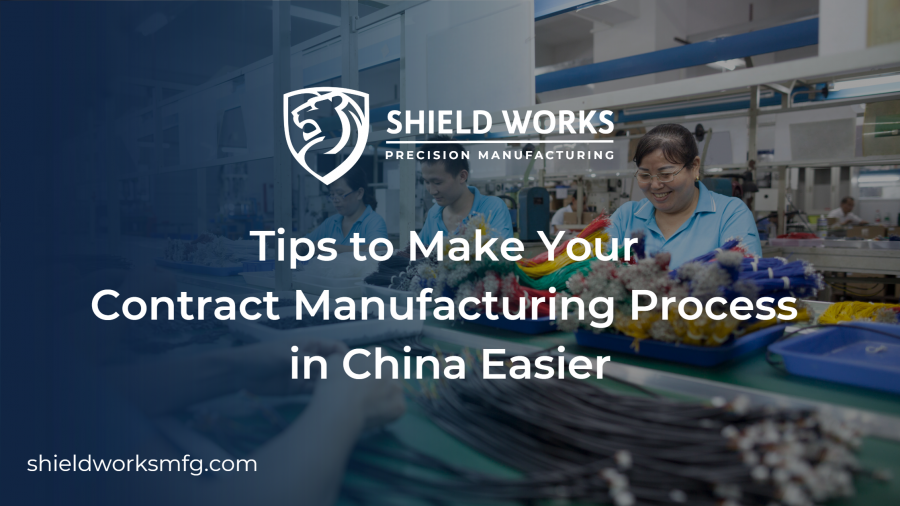
Contract manufacturing in China has become increasingly popular for businesses looking to reduce costs and take advantage of the country’s manufacturing capabilities.
However, navigating the contract manufacturing process in China can be complex and challenging, especially for those who are unfamiliar with the local business practices and cultural nuances.
In this article, we will provide you with valuable tips to make your contract manufacturing process in China easier, enabling you to optimize your operations and achieve successful outcomes.
Understanding the Chinese Manufacturing Landscape
Before diving into the tips, it’s important to have a clear understanding of the Chinese manufacturing landscape. China is renowned for its vast manufacturing infrastructure, which offers a wide range of capabilities and cost advantages.
From electronics to textiles, China has a diverse array of industries capable of meeting various production requirements. Additionally, the country boasts a skilled workforce and a strong supply chain network, further enhancing its appeal as a contract manufacturing destination.
Conduct Thorough Supplier Research
When engaging in contract manufacturing in China, conducting thorough supplier research is crucial. Look for reputable manufacturers with a proven track record in your industry. Request references and samples of their previous work to assess the quality of their products.
Make sure to verify their certifications, licenses, and compliance with international standards. Performing due diligence on potential suppliers will help you identify reliable partners and minimize the risk of working with subpar manufacturers.
Establish Clear Communication Channels
Effective communication is key to a successful contract manufacturing process. Establish clear and open lines of communication with your Chinese manufacturing partner. Overcome language barriers by hiring translators or working with bilingual staff.
Utilize video conferencing tools and project management software to facilitate real-time communication. Regularly scheduled meetings and written documentation can help ensure that both parties are on the same page regarding product specifications, timelines, and any potential issues that may arise during production.
Visit the Manufacturing Facilities
Whenever possible, plan a visit to the manufacturing facilities in China. Seeing the production process firsthand will provide valuable insights into the manufacturer’s capabilities, quality control procedures, and overall operations.
It also allows you to build stronger relationships with the suppliers, fostering trust and understanding. During your visit, take the opportunity to discuss any concerns or questions you may have, and use this face-to-face interaction to establish a solid foundation for a long-term partnership.
Emphasize Quality Control
Maintaining quality control is essential when outsourcing your manufacturing to China. Clearly define your quality standards and expectations, and ensure that your Chinese manufacturing partner understands and implements them effectively.
Implement regular inspections and quality assurance procedures to identify and rectify any issues early on. Conducting third-party inspections and audits can provide an unbiased assessment of the manufacturing process and product quality, offering you additional assurance.
Understand Intellectual Property (IP) Protection
Protecting your intellectual property is of utmost importance when working with Chinese manufacturers. While China has made significant strides in strengthening IP protection laws, it is still crucial to take necessary precautions.
File patents, trademarks, and copyrights in China to safeguard your designs and technologies. Implement non-disclosure agreements (NDAs) and confidentiality clauses to protect your trade secrets. Consult with legal experts who specialize in Chinese intellectual property laws to ensure comprehensive protection.
Build Strong Relationships
Building strong relationships with your Chinese manufacturing partners is a valuable long-term strategy. Cultivate trust and respect through open and transparent communication.
Establishing personal connections through regular visits, cultural exchanges, and social engagements can help foster a strong partnership. Invest time in understanding Chinese business culture and etiquette to avoid misunderstandings. By building strong relationships, you increase the likelihood of receiving priority treatment, improved cooperation, and enhanced mutual understanding.
Plan for Potential Challenges
While contract manufacturing in China offers numerous benefits, it is important to acknowledge and plan for potential challenges that may arise. Be prepared for delays in production, shipping, or customs clearance due to unforeseen circumstances. Maintain buffer time in your project schedule to account for these uncertainties.
Have contingency plans in place to mitigate any risks that may affect your supply chain or production timeline. Being proactive and adaptable will help you navigate challenges and ensure smooth operations.
Engaging in contract manufacturing in China can be a game-changer for businesses seeking cost-effective production solutions. By following these tips, you can streamline your contract manufacturing process and overcome common hurdles.
Remember, with careful preparation and a strategic approach, such as a manufacturer like Shield Works, with their own assembly facility, rich industry experience, and vast network of suppliers, you can make your contract manufacturing process in China easier and reap the benefits of this global manufacturing powerhouse. Contact us to know more!
Understanding the Risks of Order Consolidation
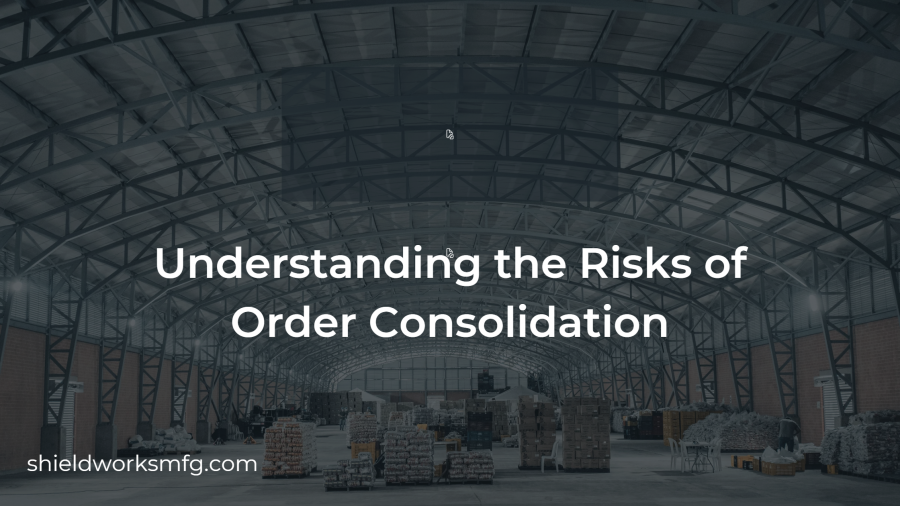
In today’s fast-paced business landscape, order consolidation has become a popular strategy for streamlining supply chain operations and optimizing costs. By combining multiple orders into a single shipment, companies can minimize transportation expenses, reduce inventory holding costs, and enhance overall efficiency. However, it is crucial to be aware of the potential risks associated with order consolidation. This article aims to shed light on these risks, their impact on businesses, and provide practical solutions for mitigating them effectively.
Inventory Management Challenges
One of the primary risks associated with order consolidation lies in inventory management. When multiple orders are consolidated, it becomes essential to manage inventory levels accurately to meet the varying demand of individual customers. Without proper control, there is a higher likelihood of stockouts or overstocking, leading to dissatisfied customers or unnecessary carrying costs. Implementing robust inventory management systems and leveraging advanced forecasting techniques can help strike the right balance and minimize these risks.
Increased Lead Times
Order consolidation often involves the synchronization of different orders from various locations, suppliers, or customers. This synchronization process can increase lead times, resulting in delayed deliveries and potential customer dissatisfaction. It is vital for businesses to closely monitor lead times and establish clear communication channels with all stakeholders involved in the consolidation process. By improving coordination and employing real-time tracking solutions, companies can minimize the impact of increased lead times on customer satisfaction.
Quality Control Issues
Consolidating orders can sometimes introduce quality control challenges. With multiple orders combined into a single shipment, there is a risk of overlooking or missing defects, especially when the individual orders have varying quality standards. To mitigate this risk, businesses should implement stringent quality control processes at various stages of the consolidation process. Conducting thorough inspections, implementing quality checkpoints, and establishing effective feedback loops can help maintain consistent product quality and customer satisfaction.
Increased Transportation Risks
While order consolidation offers cost-saving benefits by reducing transportation expenses, it also introduces certain transportation risks. Combining multiple orders into a single shipment increases the value and volume of the cargo, making it an attractive target for theft or damage during transit. To mitigate these risks, businesses should invest in robust security measures, such as GPS tracking systems, tamper-proof packaging, and insurance coverage. Additionally, selecting reliable logistics partners with a proven track record can help ensure the safe and timely delivery of consolidated orders.
Regulatory Compliance Challenges
Order consolidation often involves compliance with various regulations, especially when dealing with international shipments. Failure to comply with these regulations can result in penalties, delays, or even legal issues. To mitigate regulatory compliance challenges, companies should stay updated with the latest rules and requirements in the relevant jurisdictions. Establishing strong relationships with customs brokers, conducting regular audits, and maintaining accurate documentation can help ensure smooth order consolidation while adhering to legal and regulatory obligations.
Customer Expectations and Communication
Consolidating orders may impact customer expectations and communication. Customers accustomed to receiving individual shipments may be surprised or disappointed when their orders are combined. To manage customer expectations effectively, businesses should proactively communicate the benefits of order consolidation, such as reduced costs and enhanced sustainability. Additionally, providing accurate tracking information, timely updates, and exceptional customer service can help maintain transparency and build trust with customers.
Order consolidation can be a valuable strategy for optimizing supply chain operations and reducing costs. However, it is crucial to understand the associated risks and implement appropriate measures to mitigate them effectively.
Striking a balance between cost-saving measures and potential drawbacks is essential to achieve a streamlined and efficient supply chain while ensuring customer satisfaction and long-term success in today’s competitive business environment.
If you are new to this business with a need for order consolidation partnerships, feel free to contact Shield Works!
Streamlining OEM Sourcing: Best Recommendations & Tips

When it comes to Original Equipment Manufacturer (OEM) sourcing, efficiency and effectiveness are crucial for businesses. Streamlining the process of finding and selecting OEM suppliers can significantly impact a company’s productivity, cost-savings, and overall success. In this article, we will explore the best recommendations and tips to streamline OEM sourcing, enabling businesses to optimize their supply chain management and achieve their goals.
Understanding OEM Sourcing
Before diving into the recommendations and tips, it’s essential to understand what OEM sourcing entails. OEM sourcing involves partnering with external manufacturers to produce components, parts, or products that will be sold under a company’s brand name. This strategic approach allows businesses to leverage specialized expertise and resources while focusing on their core competencies.
Assessing Your Requirements
To streamline the OEM sourcing process, start by assessing your requirements thoroughly. This step involves understanding your product specifications, quality standards, production volume, budget constraints, and delivery timelines. Consider the following recommendations:
- Conduct a comprehensive product analysis: Define the exact specifications and features required for your product. This analysis will help you communicate your requirements effectively to potential OEM suppliers.
- Determine quality standards: Specify the quality standards that your product must meet. This ensures that your OEM supplier can deliver products that align with your brand’s reputation.
- Evaluate production volume: Assess your anticipated production volume to identify suppliers capable of meeting your demand. This evaluation will help you avoid overcapacity or undercapacity issues.
- Define budget constraints: Determine your budget limitations and negotiate pricing with potential suppliers accordingly. Balancing cost and quality is crucial in selecting the right OEM partner.
- Establish delivery timelines: Set realistic delivery timelines and ensure that your OEM supplier can meet your deadlines consistently.
Conducting Market Research
To streamline OEM sourcing, thorough market research is essential. By exploring various options and assessing potential suppliers, you can make informed decisions. Consider the following tips:
- Identify potential suppliers: Utilize industry directories, online platforms, and trade shows to identify potential OEM suppliers. Look for reputable manufacturers with experience in your industry and the desired product category.
- Evaluate supplier capabilities: Assess the capabilities and strengths of potential suppliers. Consider factors such as production capacity, technology, certifications, quality control processes, and their track record with other clients.
- Request samples and prototypes: Request samples or prototypes from shortlisted suppliers to evaluate their product quality, design, and functionality. This step ensures compatibility with your requirements.
- Check references and reviews: Seek references from other clients who have worked with the shortlisted suppliers. Additionally, check online reviews and ratings to gain insights into their reputation and customer satisfaction.
- Consider geographical proximity: Depending on your requirements, consider the advantages of working with suppliers in close proximity. Proximity can lead to faster communication, reduced shipping costs, and better control over production processes.
Building Strong Partnerships
Once you have identified potential OEM suppliers, building strong partnerships is crucial for long-term success. Follow these recommendations to foster productive relationships:
- Communication and collaboration: Establish open lines of communication with your OEM suppliers. Maintain regular contact to address any concerns, provide feedback, and ensure a shared understanding of expectations.
- Clearly define roles and responsibilities: Clearly outline the roles and responsibilities of both parties involved. This clarity helps prevent misunderstandings and promotes efficient collaboration.
- Establish quality control processes: Work with your OEM suppliers to develop comprehensive quality control processes. Regular audits and inspections can help ensure consistent product quality and adherence to specifications.
- Implement performance metrics: Define key performance indicators (KPIs) to assess your OEM suppliers’ performance. Track metrics such as on-time delivery, defect rates, and customer satisfaction to measure their effectiveness.
- Foster continuous improvement: Encourage your OEM suppliers to invest in innovation and continuous improvement. Collaborate on finding ways to optimize production processes, enhance product quality, and reduce costs.
Streamlining OEM sourcing is a critical step in optimizing your supply chain management. By assessing your requirements, conducting thorough market research, and building strong partnerships, you can streamline the process and achieve improved efficiency, cost-savings, and product quality. Embrace these recommendations and tips to ensure a successful OEM sourcing experience for your business. Remember, effective sourcing can give you a competitive edge in today’s dynamic business landscape.
Working with a manufacturer like Shield Works can help take off a lot of pressure of finding the right supplier too. With 18 years of experience in the industry and an expansive network of 500+ suppliers in Asia, you can always count on their professional service. Contact us now!
Top Benefits of Quality Inspection Services for Product Assembly in China
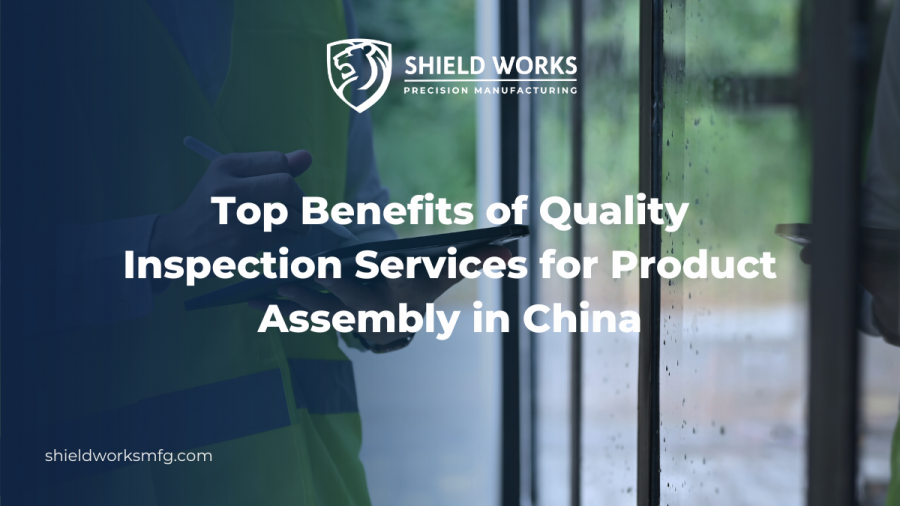
In today’s globalized marketplace, China has emerged as a manufacturing powerhouse, producing a vast array of products for companies worldwide. As businesses rely heavily on Chinese manufacturers for product assembly, ensuring the quality of these products is crucial. This is where quality inspection services play a vital role. Quality inspections provide an independent assessment of the product’s conformity to specifications, helping companies maintain high-quality standards. In this article, we will explore the top benefits of quality inspection services for product assembly in China.
Ensuring Product Quality
One of the primary benefits of quality inspection services is ensuring product quality. Manufacturers in China often face challenges related to inconsistent quality standards, counterfeit products, or deviations from agreed-upon specifications. A quality inspection carried out by experienced professionals can help identify and rectify these issues, ensuring that products meet the desired quality standards. This significantly reduces the risk of receiving defective or substandard goods, ultimately safeguarding the reputation of businesses.
Minimizing Product Defects and Returns
Product defects and returns can be costly for businesses, leading to financial losses and customer dissatisfaction. By implementing quality inspection services, companies can minimize these risks. Inspections can identify potential defects, such as faulty components, improper assembly, or cosmetic flaws, before the products are shipped. By addressing these issues at the manufacturing stage, companies can significantly reduce the number of defective products reaching the market, thereby saving costs associated with returns and replacements.
Compliance with Regulatory Standards
Adhering to regulatory standards and certifications is crucial for businesses operating in various industries. Quality inspection services help ensure that products meet the necessary regulatory requirements and comply with industry standards. These inspections cover aspects such as safety, labeling, documentation, and environmental regulations. By partnering with inspection agencies familiar with the specific regulations in China, companies can ensure their products meet all the necessary compliance standards.
Supplier Performance Evaluation
China’s manufacturing landscape is vast and diverse, with numerous suppliers offering product assembly services. Quality inspection services provide an effective means of evaluating supplier performance. By conducting inspections, companies can assess the capabilities and reliability of their suppliers, ensuring they meet the desired quality standards consistently. This evaluation process helps businesses identify and address potential issues early on, fostering stronger relationships with reliable suppliers and mitigating risks associated with poor supplier performance.
Enhanced Customer Satisfaction
Product quality is directly linked to customer satisfaction. By implementing quality inspection services, companies can demonstrate their commitment to delivering high-quality products to their customers. Consistently delivering defect-free products enhances customer trust and loyalty, leading to positive brand perception and increased customer satisfaction. Quality inspections provide the necessary assurance that the products meet or exceed customer expectations, ultimately contributing to long-term customer relationships and repeat business.
Conclusion
Quality inspection services play a crucial role in ensuring the integrity and quality of products assembled in China. By leveraging these services, businesses can mitigate risks associated with product defects, comply with regulatory standards, evaluate supplier performance, and enhance customer satisfaction. In an increasingly competitive market, maintaining high-quality standards is vital for businesses to establish a strong reputation and gain a competitive edge. By partnering with reputable quality inspection agencies, companies can effectively monitor and improve the quality of their products, fostering trust among customers and stakeholders alike.
Work With a Western-owned Product Assembly Supplier in China
Many overseas companies may feel more comfortable working with a Western-owned product assembly supplier in China. This is because they think that a company with Western management background has higher standards and more positive reactions, so they don’t need to worry about the product quality.
If you’re looking for a company that has all your security needs covered, look no further than Shield Works.
We are a British-owned and managed company that specializes in the high-quality and competitive rate of contract manufacturing and product assembly services. We follow a rigorous process to ensure quality and consistency from order to delivery. Start your journey by reaching out today for more information and see how we will be able to make them worth every penny!
How Contract Manufacturing Can Help Streamline Your Production

In today’s fast-paced business world, finding effective ways to streamline your production process is crucial to stay ahead of the competition. One strategy that can significantly boost your efficiency and productivity is contract manufacturing. Now, you might be wondering, “What exactly is contract manufacturing, and how can it benefit my business?” Well, my friend, you’ve come to the right place. In this article, we’ll dive deep into the world of contract manufacturing and explore how it can help take your production to new heights.
Understanding Contract Manufacturing: The Basics
Let’s start with the basics. Contract manufacturing, also known as outsourcing or third-party manufacturing, is a business arrangement where a company hires another company, typically a specialized manufacturer, to produce components, products, or complete assemblies on their behalf. In simpler terms, it’s like having a trusted partner who handles the manufacturing process while you focus on other critical aspects of your business.
The Benefits of Contract Manufacturing
Now that we’ve covered the definition, let’s explore the various benefits that contract manufacturing brings to the table.
1. Cost Savings and Improved Efficiency
When you choose contract manufacturing, you can reap significant cost savings. Instead of investing heavily in establishing your own production facilities, hiring specialized staff, and purchasing expensive equipment, you can leverage the existing infrastructure and expertise of the contract manufacturer. This means you can reduce your upfront capital expenditure and operational costs, allowing you to allocate your resources more efficiently.
2. Access to Specialized Skills and Technologies
One of the key advantages of contract manufacturing is gaining access to specialized skills and technologies that may not be available in-house. Contract manufacturers are experts in their respective fields, equipped with the knowledge and experience to handle complex production processes. By partnering with them, you can tap into their specialized capabilities, leverage their cutting-edge technologies, and ensure that your products are manufactured to the highest standards of quality.
3. Flexibility and Scalability
In today’s ever-changing market landscape, flexibility and scalability are paramount. Contract manufacturing offers the flexibility to adjust your production volume based on demand fluctuations without incurring excessive costs. Whether you need to scale up during peak seasons or scale down during slower periods, your contract manufacturer can adapt to your needs, providing you with the agility required to stay competitive.
4. Focus on Core Competencies
By entrusting your manufacturing operations to a contract manufacturer, you can redirect your focus and resources towards your core competencies. Instead of spreading yourself thin by trying to handle every aspect of production, you can concentrate on product development, marketing, and building stronger relationships with your customers. This allows you to play to your strengths and differentiate yourself in the market.
5. Quality Assurance and Regulatory Compliance
Maintaining consistent product quality and complying with industry regulations are vital for any business. Contract manufacturers have established quality control processes in place to ensure that every product meets the specified standards. Moreover, they stay updated with the latest regulatory requirements, saving you the time and effort of navigating complex compliance frameworks. This gives you peace of mind, knowing that your products are in capable hands.
Finding the Right Contract Manufacturer
Now that you understand the advantages of contract manufacturing, it’s important to know how to choose the right partner for your business. Here are a few key factors to consider:
Experience and Expertise
Look for a contract manufacturer with a proven track record in your industry and the relevant expertise to handle your specific manufacturing needs.
Quality Management
Assess their quality management systems and certifications to ensure they adhere to stringent quality standards.
Production Capacity
Evaluate their production capacity to ensure they can meet your volume requirements, both now and in the future.
Communication and Collaboration
Strong communication and collaboration are essential for a successful partnership. Choose a contract manufacturer that values open and transparent communication.
Cost Structure
While cost shouldn’t be the sole determining factor, it’s important to have a clear understanding of the contract manufacturer’s pricing structure to ensure it aligns with your budget and business goals.
Taking Your Production to New Heights
In conclusion, contract manufacturing can be a game-changer for your business. It offers numerous benefits, including cost savings, access to specialized skills, flexibility, and the ability to focus on your core competencies. By finding the right contract manufacturer who understands your unique requirements, you can streamline your production process and position yourself for growth and success in today’s competitive market.
So, my friend, if you’re ready to unlock the full potential of your production capabilities, it’s time to consider contract manufacturing. Embrace the power of collaboration, leverage the expertise of trusted partners, and watch your production efficiency soar. Shield Works can provide you just that with their world-class facility and vast supplier network. Remember, success favors those who adapt and evolve with the changing times. Stay ahead of the curve and contact us today!
Maximizing Cost Efficiency with Contract Assembly in China
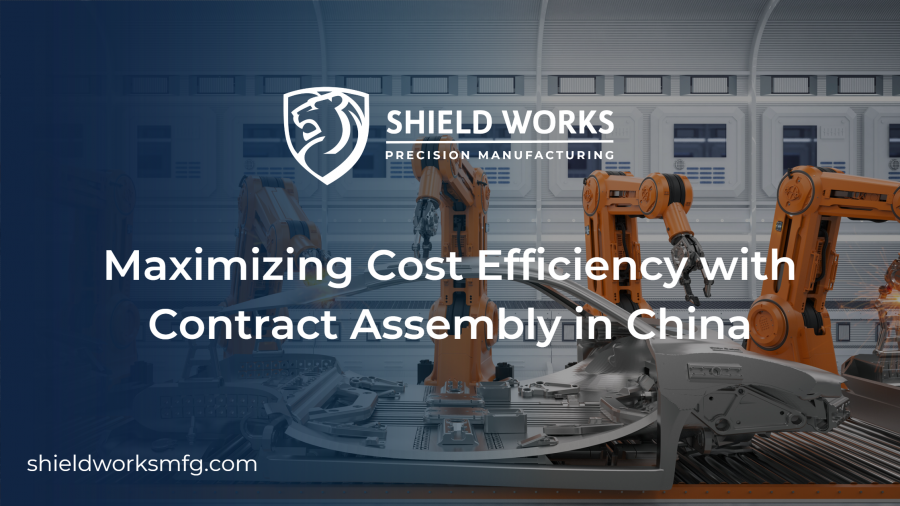
If you’re looking to maximize cost efficiency and streamline your manufacturing process, then you’ve come to the right place. In this article, we’ll dive into the world of contract assembly in China and how it can be a game-changer for your business. By outsourcing your assembly needs to experienced contract manufacturers in China, you can tap into their expertise, infrastructure, and cost advantages to achieve remarkable results. So, buckle up and let’s explore how contract assembly in China can help you boost your business while keeping costs in check!
Why Choose Contract Assembly?
When it comes to manufacturing, time and cost are crucial factors. Contract assembly offers a cost-effective solution that allows you to focus on your core competencies while leaving the assembly work to the experts. By partnering with a reliable contract assembly provider in China, you can save substantial costs associated with infrastructure, equipment, labor, and training.
The Benefits of Contract Assembly in China
1. Cost Efficiency
One of the biggest advantages of contract assembly in China is the significant cost savings it offers. China has a well-established manufacturing ecosystem with a vast network of suppliers, skilled labor, and economies of scale. By leveraging this infrastructure, contract manufacturers can streamline production processes, optimize resource allocation, and negotiate favorable pricing for components and materials. These cost savings can be passed on to you, allowing you to achieve higher profitability and remain competitive in the market.
2. Manufacturing Expertise
China has emerged as a global manufacturing hub, known for its manufacturing expertise and capabilities. Contract assembly providers in China have a wealth of experience in various industries and can handle complex assembly tasks with precision. They possess the technical know-how to tackle challenges efficiently and ensure high-quality output. With their expertise, you can rest assured that your products will be assembled to meet the highest standards of quality and reliability.
3. Scalability and Flexibility
In today’s dynamic business landscape, scalability and flexibility are key to staying ahead of the game. Contract assembly in China offers you the ability to scale your production up or down according to market demand. Whether you need to ramp up production to meet a surge in orders or adjust volumes during slow periods, contract manufacturers can adapt to your needs. This scalability and flexibility provide you with a competitive edge and the agility to respond swiftly to changing market conditions.
4. Reduced Time to Market
Time is of the essence in the business world, and contract assembly can help you accelerate your time to market. By entrusting the assembly process to specialized manufacturers, you can eliminate the need for in-house assembly, which often involves time-consuming setup, training, and coordination. Contract assembly providers in China have established assembly lines, skilled labor, and efficient processes in place, enabling them to deliver products faster and meet your deadlines.
5. Quality Control and Compliance
Maintaining stringent quality control standards is crucial for any business. Contract assembly providers in China understand the importance of quality and adhere to rigorous quality control measures. They implement quality management systems, perform inspections and tests at various stages of the assembly process, and ensure compliance with industry standards and regulations. With their focus on quality, you can have peace of mind knowing that your products will meet or exceed customer expectations.
How to Choose the Right Contract Assembly Partner
Selecting the right contract assembly partner is vital to the success of your outsourcing venture. Here are a few factors to consider when choosing a contract assembly provider in China:
Experience and Expertise
Look for a provider with a proven track record and extensive experience in contract assembly. Assess their industry knowledge, technical capabilities, and the types of products they have assembled in the past.
Quality Assurance
Ensure that the contract manufacturer has robust quality control processes in place. Ask about their certifications, inspection procedures, and commitment to meeting quality standards.
Infrastructure and Capacity
Evaluate the provider’s manufacturing facilities, equipment, and production capacity. Consider whether they have the necessary resources to meet your volume requirements and accommodate future growth.
Communication and Collaboration
Effective communication and collaboration are essential for a successful partnership. Choose a contract assembly provider that demonstrates clear and prompt communication, understands your requirements, and can provide regular updates on the progress of your assembly projects.
Cost Considerations
While cost efficiency is a significant driver for contract assembly, it’s essential to strike a balance between cost and quality. Compare pricing models, explore value-added services, and ensure that the provider offers transparent pricing structures.
You’ve just gained valuable insights into the world of contract assembly in China and how it can help you maximize cost efficiency. By outsourcing your assembly needs to experienced contract manufacturers, you can tap into their expertise, leverage cost advantages, and achieve remarkable results. Remember to carefully evaluate potential partners based on their experience, quality assurance practices, infrastructure, communication, and cost considerations, which make Shield Works you perfect choice with their years of experience and global team members.
So, if you’re ready to take your business to the next level, consider the benefits of contract assembly in China. It’s time to enhance your competitiveness in the market by calling us today!
Quality Control Measures Used by Contract Manufacturers
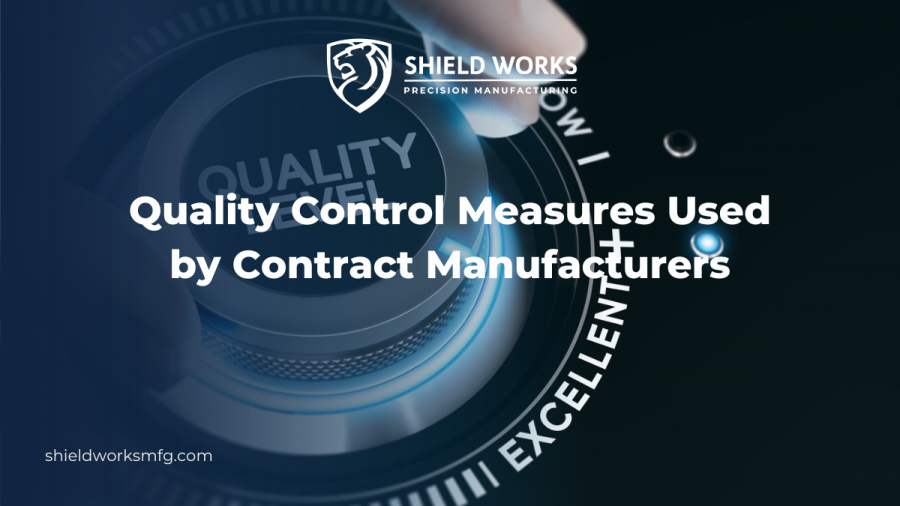
More than 60% of business leaders surveyed said that higher quality is a frequent customer demand. Meeting that demand is essential for your company to thrive.
Global manufacturing is in a period of transition. Economic conditions pose challenges. Opportunities still exist, though.
Many companies are taking advantage of contract manufacturing to lower costs and reduce production time. Quality control measures are an important consideration for supply outsourcing. You need assurance that your manufacturer has tight adherence to standards.
Learn more about what contract manufacturers can do to ensure the quality of your products.
Quality Control, Quality Assurance, and Quality Management
Your contract manufacturer should have a robust quality management plan. Quality management includes quality control and quality assurance.
Quality control helps ensure that products from your contract manufacturer meet your quality standards. It focuses on finding, recording, and categorizing any product flaws.
Quality assurance puts processes in place to meet quality standards and avoid product defects. It’s proactive and preventive. Quality control measures check to be sure that those processes are working as intended.
Quality Management Certification
Your contract manufacturer should have a quality management certification. ISO 9001 is one of the top-quality certifications. It’s an international standard.
Following ISO 9001 gives a manufacturer the foundation for an effective quality management system.
Any organization of any size can use ISO 9001. ISO 9001 involves an auditing process that the manufacturer must repeat every three years. It helps ensure you get consistently high-quality products.
100% Inspection Quality Control Method
As the name suggests, the 100% inspection method examines every item in a production run. This method is very effective. It helps remove almost any product that isn’t exactly in spec.
However, inspecting each item is time-consuming and expensive. This method is only cost-effective when the consequences of a defective product are very serious. It may also be necessary if you are reasonably certain that a batch has flawed items.
Acceptance Sampling Method
Acceptance sampling randomly inspects a certain number of items in the lot. The number of units you need to test depends on the size of the lot. The sample must be large enough to allow an accurate conclusion.
If the number of flawed products in the sample is low, you accept the lot. If the number of flaws is too high, you reject the lot.
Acceptance sampling relies on statistical inference. This makes it less accurate than the 100% inspection method. It tells you whether a lot is likely to be acceptable, not the quality of the lot.
However, acceptance sampling is faster and less expensive than 100% inspection. It’s also a good option if testing destroys the product.
Statistical Quality Control (SQC)
Statistical quality control goes beyond acceptance sampling. It uses sampling inspections, data analysis, and control charting. The quality control tools include:
- Check sheet
- Histogram
- Pareto chart
- Control chart
- Cause-and-effect diagram
- Scatter diagram
- Stratification
A manufacturer may use some or all of these statistical techniques.
Check Sheets
Check sheets help the manufacturer gather data. They help ensure that data collection is effective and efficient.
Histograms
A histogram is a bar chart. It represents the frequency distribution of data. It helps the manufacturer understand where and when a product’s characteristic varies.
Pareto Charts
A Pareto chart is a combination of a bar chart and a line graph. It highlights the relative importance of different production parameters. This helps the manufacturer focus on the factors that will resolve the most problems.
Control Charts
A control chart documents when unusual process variations occur. It helps the manufacturer determine whether specific factors are affecting the current process. It helps to predict process performance.
Cause-and-Effect Diagrams
A cause-and-effect diagram helps the manufacturer identify the causes of a problem. These diagrams are also called fishbone diagrams because of how they look. The diagram has a quality-related problem on one side and root causes and sub-causes on the other side.
The technique uses structured brainstorming to try to find less-obvious causes for the problem.
Scatter Diagrams
A scatter diagram represents the relationship between two variables. It’s another way to identify cause-and-effect relationships.
However, a scatter diagram doesn’t prove causality. The manufacturer needs to conduct an experiment to determine if a potential factor is the cause of the problem. They can then implement a more focused solution for the problem.
Stratification
Stratification is used with other data analysis techniques. It separates data, objects, and people into different groups. It helps reveal patterns that might not be visible otherwise.
Six Sigma and Lean Six Sigma
Six Sigma is a methodology for quality management. The goal is to reduce defects and errors by minimizing variance in the manufacturing process. Six Sigma uses a process of steps called DMAIC:
- Define the problem
- Measure current performance
- Analyze the process
- Improve the process by eliminating the causes of any problems
- Control the process to ensure problems don’t reoccur
This approach is data-driven. It goes beyond basic quality control to optimize total business processes.
Lean Six Sigma
Lean Six Sigma combines Six Sigma with the lean manufacturing method. Lean manufacturing focuses on minimizing production waste and maximizing efficiency. In addition to reducing defects, it aims to minimize:
- Overproduction
- Wait time
- Non-utilized talent
- Inefficient transportation
- Excess inventory
- Unnecessary movements
- Excessive processing
Lean Six Sigma is a comprehensive approach to process management.
The Importance of Quality Control Measures in Contract Manufacturing
Robust quality control measures are essential for a contract manufacturer.
Quality control helps you better manage costs. It results in lower scrap levels. Labor costs are lower through less handling and rework.
Minimizing defective products protects your brand. You improve customer loyalty. You protect yourself from liability.
Your contract with the manufacturer should define the manufacturing standards for your product. It should outline their specific quality control processes to meet those requirements.
Finding a Contract Manufacturer with the Right Quality Control Measures
A variety of quality control measures can help your contract manufacturer meet your production standards. Finding a manufacturer who has the right measures in place is the key.
Shield Works Precision Manufacturing is reinventing contract manufacturing. Our British-owned and managed facilities are located in the rapidly developing South China Greater Bay Area.
We hold ISO 9001 certification. You can rely on our adherence to standards and transparency. You benefit from our competitive cost structure and international experience.
Contact Shield Works today to discuss your manufacturing needs. We look forward to exceeding your expectations.
Collaborating with a Product Assembly Company in China: 10 Factors to Keep in Mind

Quality Control: Ensuring Top-notch Products
To achieve a successful manufacturing outcome, it is imperative to ensure that the assembly company produces finished products that meet your standards. Engage in a thorough discussion about the company’s quality control processes and consider visiting their facility to witness their operations firsthand. By doing so, you can ensure that the products align with your specifications and establish clear quality standards to address any issues that may arise.
Lead Times: Factoring in Production and Delivery
Understanding lead times for production and delivery is crucial for effective planning. Consider potential delays that may occur due to holidays or unexpected events. Incorporate adequate time for production and delivery into your project timeline to avoid any disruptions. Additionally, it is prudent to prepare contingency plans to mitigate unexpected delays.
Communication: The Key to a Smooth Working Relationship
Establishing clear lines of communication with the assembly company is vital for a successful collaboration. Designate a point of contact and encourage open dialogue to promptly address any concerns or issues that may arise. Regular check-ins with the company will help you stay informed about the project’s progress and maintain a transparent working relationship.
Costs: Understanding the Full Picture
Comprehending all the costs associated with working with the assembly company is essential. This includes material costs, labor expenses, and any additional fees. Negotiate a fair price and request a written quote to avoid misunderstandings. Moreover, allocate a budget for potential additional costs that may arise during the production process.
Intellectual Property Protection: Safeguarding Your Innovations
Protecting your intellectual property is of utmost importance when collaborating with a product assembly company in China. Ensure that the company has established agreements, such as non-disclosure agreements and intellectual property licensing agreements, to safeguard your innovations. Registering your intellectual property in China provides an additional layer of protection against unauthorized use or disclosure.
Legal Considerations: Navigating the Business Landscape
Navigating potential legal issues is crucial when working with a company in China, as business practices and regulations may differ. Seek legal aid to assist you in understanding contracts, agreements, and regulatory matters. This ensures that your interests are protected and helps you navigate any legal challenges that may arise.
Cultural Awareness: Bridging the Gap
Being mindful of cultural differences fosters a strong working relationship with a product assembly company in China. Show respect for their culture and practices, adapting to different business customs and communication styles. Educate yourself on Chinese culture and customs to better understand the perspective of the assembly company and strengthen collaboration.
Sustainability: Minimizing Environmental Impact
Consider the environmental impact when working with a product assembly company in China. Look for companies that prioritize reducing their carbon footprint and minimizing environmental harm. This aligns with the growing importance of sustainability and can positively impact your customers’ perception. Engage in discussions with the assembly company about their sustainability practices.
Flexibility: Adapting to Challenges
Remaining flexible and open to finding solutions when challenges arise is key to a successful collaboration. Adjust product designs or production timelines to accommodate the assembly company’s capabilities or constraints. This flexibility ensures a smoother manufacturing process and helps overcome potential obstacles.
Payment Terms: Ensuring Fairness and Security
Clearly defining payment terms that are fair and reasonable for both parties is essential. Consider using mechanisms like letters of credit or escrow accounts to provide security and protect yourself in case of disputes. This ensures timely and secure payments for your collaboration.
By carefully considering these ten factors, you can significantly increase your chances of success when working with a product assembly company in China. Establishing clear communication channels, protecting your intellectual property, and working with an experienced assembly company like Shield Works, which boasts its own facility and legal partnerships, will streamline the manufacturing process. Contact us today for more information!
Unveil the Unspoken Advantages of OEM Manufacturing in China
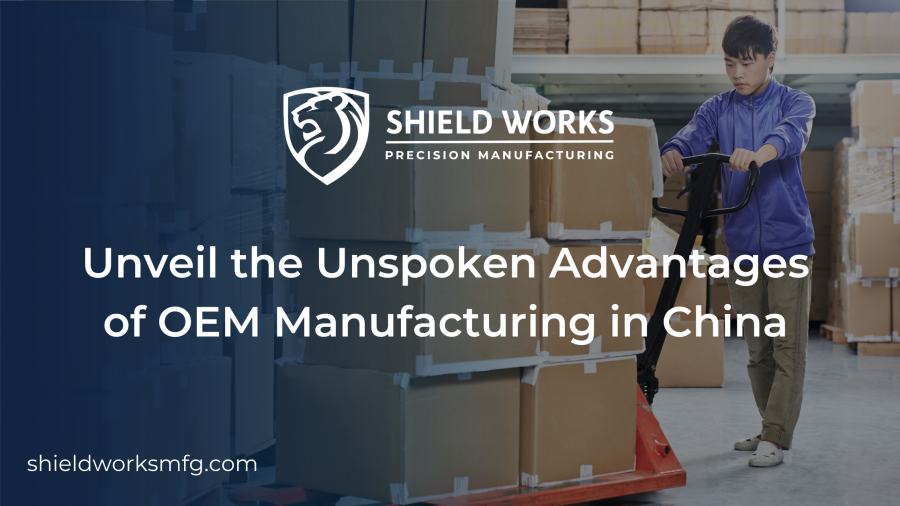
OEM manufacturing in China has revolutionized the global market, providing businesses with an array of advantages to expand their reach and maximize their profits. While many are aware of the cost savings and larger customer base associated with China’s OEM manufacturing, there are several hidden perks that often go unnoticed. In this article, we will delve into five lesser-known benefits of OEM manufacturing in China, shedding light on the secrets that can elevate your business to new heights. So, keep reading to discover the hidden gems of OEM manufacturing in China that have remained untold until now!
Cost-Effectiveness: Unlocking the Power of Savings
OEM manufacturing in China has gained immense popularity over the past few decades due to its unparalleled cost-effectiveness. China offers lower production costs, reduced wages, and decreased overhead expenses compared to other countries, enabling businesses to stay competitive and maximize their profits.
In addition to the general cost savings achieved by outsourcing production to China, there are other financial benefits that often go unnoticed. By having components manufactured in close proximity to the source of raw materials, companies can significantly reduce shipping costs. Moreover, China’s vast production scale allows businesses to enjoy bulk discounts and better pricing on raw materials, further enhancing their cost-effectiveness.
By keeping production in China, businesses can avoid long-term investments in expensive equipment and staff. This strategic move enables companies to allocate their resources more effectively, focusing on core aspects of their business and driving growth.
A Profusion of Skilled Workers: The Backbone of Success
Finding reliable workers for OEM manufacturing in China is a breeze, thanks to the abundance of highly skilled and experienced labor available. With over 800 million people in China’s labor force, it stands as one of the largest markets for hiring workers.
Not only does China boast a large pool of skilled workers, but their wages are also significantly lower compared to those in other developed countries. This makes China an excellent choice for companies aiming to reduce costs and increase their profit margins. Furthermore, many Chinese factories are open to negotiating prices and terms, providing businesses with an opportunity to strike favorable deals when engaging in manufacturing services.
China’s extensive network of suppliers and raw materials, coupled with the dedication and drive of its workforce, ensures that manufacturing projects are completed on time and with the highest quality standards. By tapping into this vast pool of skilled workers, businesses can save money while still achieving outstanding results.
Efficient Lead Times: Accelerating Your Success
One of the biggest hidden advantages of OEM manufacturing in China lies in its efficient lead times. OEM manufacturers in China have established robust supply chains that expedite production, enabling businesses to bring their products to market faster.
Chinese OEM manufacturers have forged extensive networks of suppliers and raw materials, streamlining the process of preparing products for sale. This not only saves businesses time but also reduces costs associated with lengthy lead times. Additionally, Chinese manufacturers possess profound expertise in international logistics, often providing competitive shipping rates. Leveraging these services can result in reduced shipping costs and faster delivery of products to customers, benefiting businesses that rely on quick turnaround times.
Moreover, OEM manufacturers in China excel in fulfilling orders promptly and efficiently. With established processes and systems in place, they ensure that orders are processed and delivered promptly, minimizing the stress of order management and guaranteeing timely delivery to customers.
Quality Control: Elevating Your Standards
Quality control is a paramount aspect of OEM manufacturing in China. Ensuring that all components are created with precision and accuracy, and that the finished product meets the highest quality standards, is of utmost importance. When partnering with OEM manufacturers in China, you can rest assured that rigorous quality control processes are followed and enforced.
Manufacturing processes in China adhere to relevant quality standards and regulations. Many Chinese manufacturers are also required to subject their products to independent 3rd-party certification agencies for testing before they can be sold. This rigorous approach ensures that all products meet stringent quality and safety requirements.
Advanced technologies such as Computer Aided Design (CAD) and Computer Aided Manufacturing (CAM) are extensively employed by OEM manufacturers in China to guarantee precise and accurate production processes. These cutting-edge tools enable the production of complex components with a high level of accuracy and consistency.
Experienced technicians closely monitor the production process, promptly identifying and rectifying any issues that arise, ensuring that the finished product attains the highest quality standards.
Technology and Innovation: Pioneering the Future
One aspect often overlooked is China’s unwavering commitment to developing and implementing cutting-edge technology and innovation. OEM manufacturers in China lead the way in modern manufacturing solutions, embracing the latest equipment, advanced machinery, and emerging technologies.
Efficient processes powered by artificial intelligence (AI) and robotics are at the forefront of China’s manufacturing landscape. These innovations significantly reduce production costs and time-to-market, enabling businesses to achieve optimal efficiency.
Moreover, Chinese manufacturers have heavily invested in factory automation and quality control measures. As a result, many OEM manufacturers can produce components with exceptional accuracy and consistency. This perfect synergy between technology and innovation ensures the delivery of high-quality products that exceed customer expectations, all while maintaining cost-effectiveness.
The Chinese government actively supports the country’s quest for innovative solutions, offering substantial funding to initiatives like the Made in China 2025 program. This program encourages OEM manufacturers to adopt new technologies and automation solutions, ensuring that Chinese manufacturers remain competitive in an increasingly globalized market.
Choose the Best: Shield Works
Amidst the sea of options available, selecting the right OEM manufacturing partner can be a daunting task. To ensure a successful collaboration, opt for a company that possesses an in-house design and engineering team, extensive supplier networks, and industry experience. Shield Works stands out as the ideal choice, equipped with the expertise and capabilities to advance your business goals.
Contact us today and discover how Shield Works can assist you in achieving your manufacturing objectives. With our unwavering commitment to quality and innovation, we are ready to elevate your business to new heights!
